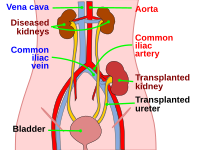
Photo from wikipedia
Living Kidney Donor Transplantation (LKDT) is the first therapeutic choice in end stage renal disease (ESRD). Donor safety has to be ensured, throughout an extensive pre operative screening. Venous thromboembolism… Click to show full abstract
Living Kidney Donor Transplantation (LKDT) is the first therapeutic choice in end stage renal disease (ESRD). Donor safety has to be ensured, throughout an extensive pre operative screening. Venous thromboembolism (VTE) and deep vein thrombosis(DVT) are the most frequent complications after abdominal surgery. Living kidney donation is considered a safe procedure, with a major morbidity rate around 5%, and a not clearly defined incidence of VTE and DVT. We thus proceeded to evaluate the thrombophilic risk among potential kidney donors to define an adequate prophylactic strategy. Our Transplant Center introduced thrombophilic screening in all potential donors from 2019. We checked clinical history for previous thrombotic events, active or treated malignacies. Our thombophilic risk panel comprehended: Lupus Anticoagulant (LAC), Factor V -II-VIII, in Protein C and S activity. In case of LAC undetermined results on two consecutive samples, we tested anti-cardiolipin and anti-beta2-glycoprotein 1 antibodies. Nephrectomy was performed by mini-invasive robotic technique; anticoagulation was provided by Enoxaparin 4000U 7-14 days. We studied 32 potential donors. No previous thrombotic events were reported. Malignancies were observed in 4 patients (12.5%), 1 before starting the study and 3 were discovered during the evaluation (MGUS, non small cell lung carcinoma). Thrombophilic screening showed uncertain LAC in 3 (9%) patients, an heterozygote mutation in Factor V associated with APC positivity in 1 patient(3%), heterozygote mutation in Factor II in 3(9%) disorder in Protein C S and Factor VIII activity respectively in 4 (12.5%) 3(9%)and 4(12.5%) patients. Among the 9 patients deemed fit for donation: uncertain LAC in 1(11%) patient, heterozygote mutation in Factor II in 1 (9%) patient. No thrombotic event was reported after donation. The frequency of coagulation disorders among kidney living donor is low, but not negligible. Appropriate medical history assessment and thrombophilic screening before donation is recommended, as well as an antithrombotic prophylaxis with Enoxaparin from 7 to 14 days after nephrectomy, tailored on each patient risk factors. This strategy allowed to avoid thrombotic events in patients who underwent nephrectomy. More data are necessary to draw more solid conclusions.
Journal Title: Nephrology Dialysis Transplantation
Year Published: 2021
Link to full text (if available)
Share on Social Media: Sign Up to like & get
recommendations!